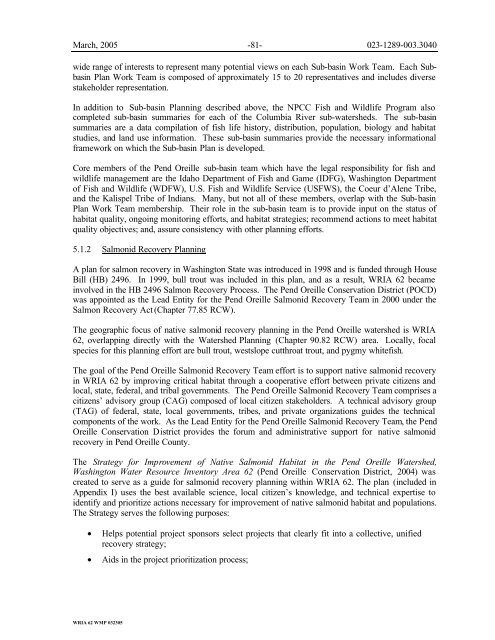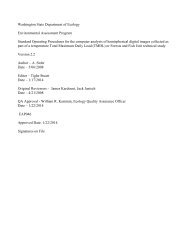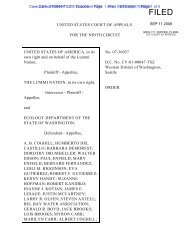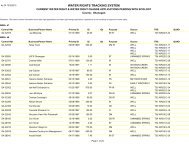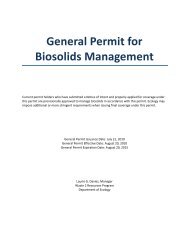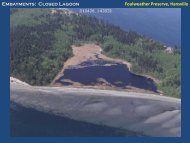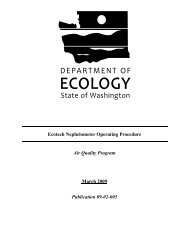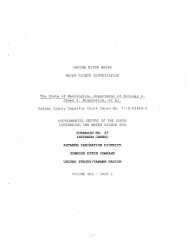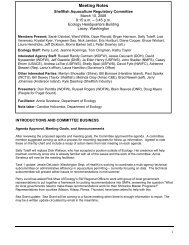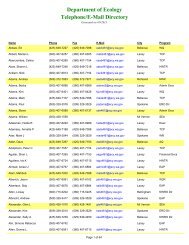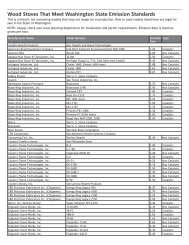WRIA 62 WMP 032305 - Washington State Department of Ecology
WRIA 62 WMP 032305 - Washington State Department of Ecology
WRIA 62 WMP 032305 - Washington State Department of Ecology
Create successful ePaper yourself
Turn your PDF publications into a flip-book with our unique Google optimized e-Paper software.
March, 2005 -81- 023-1289-003.3040<br />
wide range <strong>of</strong> interests to represent many potential views on each Sub-basin Work Team. Each Subbasin<br />
Plan Work Team is composed <strong>of</strong> approximately 15 to 20 representatives and includes diverse<br />
stakeholder representation.<br />
In addition to Sub-basin Planning described above, the NPCC Fish and Wildlife Program also<br />
completed sub-basin summaries for each <strong>of</strong> the Columbia River sub-watersheds. The sub-basin<br />
summaries are a data compilation <strong>of</strong> fish life history, distribution, population, biology and habitat<br />
studies, and land use information. These sub-basin summaries provide the necessary informational<br />
framework on which the Sub-basin Plan is developed.<br />
Core members <strong>of</strong> the Pend Oreille sub-basin team which have the legal responsibility for fish and<br />
wildlife management are the Idaho <strong>Department</strong> <strong>of</strong> Fish and Game (IDFG), <strong>Washington</strong> <strong>Department</strong><br />
<strong>of</strong> Fish and Wildlife (WDFW), U.S. Fish and Wildlife Service (USFWS), the Coeur d’Alene Tribe,<br />
and the Kalispel Tribe <strong>of</strong> Indians. Many, but not all <strong>of</strong> these members, overlap with the Sub-basin<br />
Plan Work Team membership. Their role in the sub-basin team is to provide input on the status <strong>of</strong><br />
habitat quality, ongoing monitoring efforts, and habitat strategies; recommend actions to meet habitat<br />
quality objectives; and, assure consistency with other planning efforts.<br />
5.1.2 Salmonid Recovery Planning<br />
A plan for salmon recovery in <strong>Washington</strong> <strong>State</strong> was introduced in 1998 and is funded through House<br />
Bill (HB) 2496. In 1999, bull trout was included in this plan, and as a result, <strong>WRIA</strong> <strong>62</strong> became<br />
involved in the HB 2496 Salmon Recovery Process. The Pend Oreille Conservation District (POCD)<br />
was appointed as the Lead Entity for the Pend Oreille Salmonid Recovery Team in 2000 under the<br />
Salmon Recovery Act (Chapter 77.85 RCW).<br />
The geographic focus <strong>of</strong> native salmonid recovery planning in the Pend Oreille watershed is <strong>WRIA</strong><br />
<strong>62</strong>, overlapping directly with the Watershed Planning (Chapter 90.82 RCW) area. Locally, focal<br />
species for this planning effort are bull trout, westslope cutthroat trout, and pygmy whitefish.<br />
The goal <strong>of</strong> the Pend Oreille Salmonid Recovery Team effort is to support native salmonid recovery<br />
in <strong>WRIA</strong> <strong>62</strong> by improving critical habitat through a cooperative effort between private citizens and<br />
local, state, federal, and tribal governments. The Pend Oreille Salmonid Recovery Team comprises a<br />
citizens’ advisory group (CAG) composed <strong>of</strong> local citizen stakeholders. A technical advisory group<br />
(TAG) <strong>of</strong> federal, state, local governments, tribes, and private organizations guides the technical<br />
components <strong>of</strong> the work. As the Lead Entity for the Pend Oreille Salmonid Recovery Team, the Pend<br />
Oreille Conservation District provides the forum and administrative support for native salmonid<br />
recovery in Pend Oreille County.<br />
The Strategy for Improvement <strong>of</strong> Native Salmonid Habitat in the Pend Oreille Watershed,<br />
<strong>Washington</strong> Water Resource Inventory Area <strong>62</strong> (Pend Oreille Conservation District, 2004) was<br />
created to serve as a guide for salmonid recovery planning within <strong>WRIA</strong> <strong>62</strong>. The plan (included in<br />
Appendix I) uses the best available science, local citizen’s knowledge, and technical expertise to<br />
identify and prioritize actions necessary for improvement <strong>of</strong> native salmonid habitat and populations.<br />
The Strategy serves the following purposes:<br />
• Helps potential project sponsors select projects that clearly fit into a collective, unified<br />
recovery strategy;<br />
• Aids in the project prioritization process;<br />
<strong>WRIA</strong> <strong>62</strong> <strong>WMP</strong> <strong>032305</strong>


